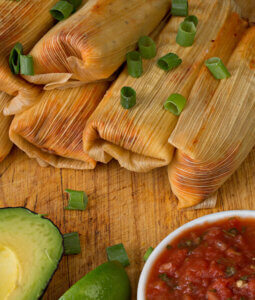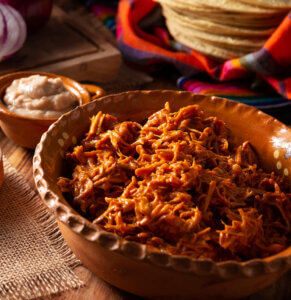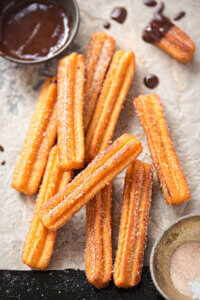Everyone, including Auguste Escoffier School of Culinary Arts, loves a good party and Cinco de Mayo probably ranks as one of the best! In Mexico, the date honors the military and commemorates El Día de la Batalla de Puebla, (The Day of the Battle of Puebla). In the United States, we celebrate the day with dance, song, and, of course…. food!
Here are five fun food facts about this festive day.
- It’s All About the Mole Sauce – In Mexico the holiday’s most beloved dish is mole poblano, a dish that originated in Puebla.
- Americans Eat Millions of Avocados on May 5th – According to the US Department of Agriculture, Americans eat over 80 million pounds of avocados on Cinco de Mayo alone
- Many Festive “Mexican” Foods Enjoyed in the US Aren’t Actually Mexican – burritos, ground beef tacos, and nachos, some of this day’s favorites, are really Tex-Mex.
- Denver’s Cinco de Mayo Festival is one of the largest in the US – With an estimated 400,000 people attending over two days to participate in parades, carnival rides, and a taco-eating contest.
- Margaritas Reign Supreme – Tequila sales are said to double in the week leading up to Cinco de Mayo, and margaritas account for nearly 50 percent of cocktails sold on the holiday.
So, now that your mouth is watering for some marvelous Mexican fare, let’s taco-bout some amazing Cinco de Mayo recipes, courtesy of Escoffier Chef Instructor, Luke Shaffer.
Tamales
YIELDS: 24 tamales
Ingredients
- 24 ea Corn husks
- 1 ½ c Lard
- As needed Kosher salt
- 1 ½ tsp Baking powder
- 3 ½ c Masa harina
- 1 ½ to 2 c Chicken stock, unsalted or low sodium
- 3 c Filling (cochinita pibil-see recipe below, chicken tinga, barbacoa, etc)
Directions
- Prepare the cornhusks, if using. Cover the husks with very hot water, weight them with a plate to keep them submerged, and let stand for a couple of hours until the husks are pliable. For forming the tamales, separate out 28 of the largest and most pliable husks—ones that are at least 6 inches across on the wider end and 6 or 7 inches long. If you can’t find enough good ones, overlap some of the large ones to give wide, sturdy surfaces to spread the batter on. Pat the chosen husks dry with a towel.
- Prepare the batter. With an electric mixer on medium-high speed, beat the lard or coconut oil with 2 teaspoons salt and the baking powder until light in texture, about 1 minute. Continue beating as you add the masa (fresh or reconstituted) in three additions. Reduce the speed to medium-low and add 1 cup of the broth. Continue beating for another minute or so, until a 1/2 teaspoon dollop of the batter floats in a cup of cold water (if it floats you can be sure the tamales will be tender and light). Beat in enough of the remaining 1/2 cup of broth to give the mixture the consistency of soft (not runny) cake batter; it should hold its shape in a spoon. Taste the batter and season with additional salt if you think it needs some. For the lightest textured tamales, refrigerate the batter for an hour or so, then reheat, adding a little more broth or water to bring the mixture to the soft consistency it had before.
- Set up the steamer. Steaming 26 husk-wrapped tamales can be done in batches in a collapsible vegetable steamer set into a large, deep saucepan. To steam them all at once, you need something like the kettle-size tamal steamers used in Mexico or Asian stack steamers, or you can improvise by setting a wire rack on 4 coffee or custard cups in a large kettle. It is best to line the rack or upper part of the steamer with leftover cornhusks to protect the tamales from direct contact with the steam and to add more flavor. Make sure to leave tiny spaces between the husks so condensing steam can drain off.
- Form the tamales. Cut twenty-six 8- to 10-inch pieces of string or thin strips of cornhusks. One at a time, form the tamales: Lay out one of your chosen cornhusks with the tapering end toward you. Spread about 1/4 cup of the batter into about a 4-inch square, leaving at least a 1 1/2-inch border on the side toward you and a 3/4-inch border along the other sides (with large husks, the borders will be much bigger). Spoon about 1 1/2 tablespoons of the filling down the center of the batter. Pick up the two long sides of the cornhusk and bring them together (this will cause the batter to surround the filling). If the uncovered borders of the two long sides you’re holding are narrow, tuck one side under the other; if wide, roll both sides in the same direction around the tamal. (If the husk is small, you may feel more comfortable wrapping the tamal in a second husk.) Finally, fold up the empty 1 1/2-inch section of the husk (to form a tightly closed “bottom” leaving the top open), and secure it in place by loosely tying one of the strings or strips of husk around the tamal. As they’re made, stand the tamales on their folded bottoms in the prepared steamer. Don’t tie the tamales too tightly or pack them too closely in the steamer. They need room to expand.
- Steam and serve the tamales. When all the tamales are in the steamer, cover them with a layer of leftover cornhusks; if your husk-wrapped tamales don’t take up the entire steamer, fill in the open spaces with loosely wadded aluminum foil (to keep the tamales from falling over). Set the lid in place and steam over a constant medium heat for about 1 1/4 hours. Watch carefully that all the water doesn’t boil away and, to keep the steam steady, pour boiling water into the pot when more is necessary. Tamales are done when the husk peels away from the masa easily. Let tamales stand in the steamer off the heat for a few minutes to firm up. For the best-textured tamales, let them cool completely, then re-steam for about 15 minutes to heat through.
Cochinita Pibil
YIELDS: 12 servings
Ingredients
- 5 Tbsp Achiote seeds
- ½ Tbsp Mexican oregano, dried
- 1 ½ Tbsp Black peppercorns
- 1 ¼ tsp Cumin seeds
- ½ tsp Cloves, whole
- 3 ea Canela stick (or cinnamon stick)
- As needed Kosher salt
- 14 ea Garlic cloves, sliced
- ½ c Orange juice, fresh squeezed
- 1 c Lime juice, fresh squeezed
- 1 ea Pork shoulder, bone-in
- 1 lb Banana leaves
Directions
- Blend the spices into a spice grinder, or mortar and pestle. Transfer to a blender and add 1 Tbsp of salt, the sliced garlic, orange juice, and lime juice. Blend together until smooth.
- Marinate the pork shoulder for at least 4 hours, if not overnight.
- Preheat the oven to 325F.
- Line a roasting pan with banana leaves, place the pork shoulder with some marinade, and wrap in banana leaves. Cover the roasting pan in foil and bake until the pork is tender (~3 1/2 to 4 hours).
- Remove from the oven and allow to rest and cool slightly before shredding the pork.
Churros
YIELDS: 12 servings
Ingredients
- 1 c Water
- 8 Tbsp Unsalted butter
- ¾ tsp Kosher salt
- 1 tsp Vanilla extract
- 1 ¼ c All-purpose flour
- 4-5 ea Eggs
- 1 Tbsp Cinnamon, ground
- ¼ c Sugar
- As needed Vegetable or Canola oil, for frying
Directions
- Combine the water, butter, salt, and vanilla extract in a medium-sized saucepan, heat until the butter has melted, and bring to a rolling boil.
- Remove the pan from the heat, and add the flour all at once, stirring vigorously.
- Return the pan to the burner and cook over medium heat, stirring all the while, until the mixture smooths out and follows the spoon around the pan; this should take less than a minute.
- Remove the pan from the heat, and let the mixture cool for 5 to 10 minutes. It’ll still feel hot, but you should be able to hold a finger in it for a few seconds. If you have an instant-read thermometer, the temperature should be below 125°F.
- Transfer the mixture to a mixer, then add the eggs one at a time. The batter will look curdled at first, but it should come back together.
- The finished batter should make a “V” when you pull the paddle out of the batter. If it is still too thick to do this, add the fifth egg and mix to incorporate.
- Transfer the batter to a piping bag fitted with a star tip. Set aside.
- In a heavy bottom pot, dutch oven, or deep fryer, heat oil to 375F. While that heats, prepare a tray or plate with paper towels to drain churros after frying. Also, combine sugar and cinnamon on a shallow dish for dusting.
- Pipe a line of batter about 6” long into the oil. Allow to cook until golden brown – about 2-3 minutes. Depending on the size of your pot, pipe 2-3 more churros being careful not to overcrowd the oil.
- Using tongs, remove churro to the paper towel-lined tray to drain for a moment, then to the cinnamon sugar and roll to coat.
- The churros should be served immediately. They can be served as-is or with chocolate or caramel sauce to dip.
Margarita
YIELDS: 1 serving
- 2 oz Blanco tequila
- ½ oz Orange liqueur, such as Cointreau or Grand Marnier
- 1 oz Lime juice, freshly squeezed
- ½ oz Agave syrup (or simple syrup)
- 1 ea Lime wedge for garnish
- As needed Kosher salt for rim garnish (optional)
Directions
- Rub the rim of a margarita glass (or rocks glass) with the lime wedge, then dip onto a plate of kosher salt to salt the rim – alternatively, rub the lime wedge along one side of the glass and dip only that section in the salt.
- Combine all ingredients (except the garnishes) in a shaker.
- Add ice and shake until chilled.
- Strain into the salted glass over fresh ice.
- Garnish with the lime wedge.
Paloma
YIELDS: 1 serving
- 2 oz Blanco tequila
- 2 oz Grapefruit juice, fresh squeezed
- ½ oz Lime juice, fresh squeezed
- ½ oz Agave nectar
- As needed Sparkling mineral water
- 1 ea Lime wheel, for garnish
Directions
- Add tequila, grapefruit juice, lime juice, and agave nectar to a shaker tin.
- Add ice and shake until well chilled
- Strain into a rocks glass over fresh ice.
- Top with sparkling mineral water and garnish with lime wheel.






